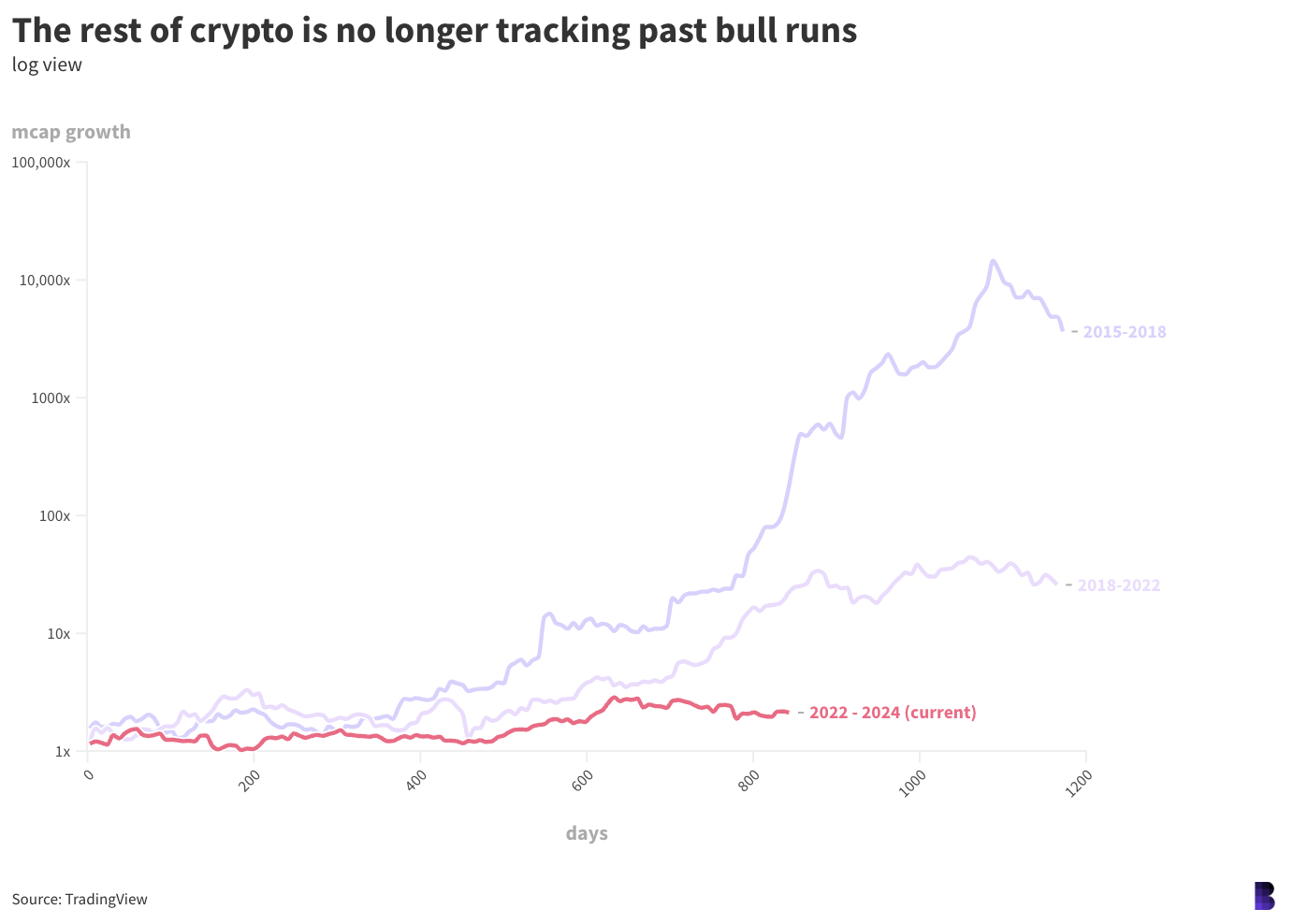Today, enjoy the Empire newsletter on Blockworks.co. Tomorrow, get the news delivered directly to your inbox. Subscribe to the Empire newsletter.
Good morning.
This week’s editions are going to look a smidge different, with so many of our folks on the ground at Permissionless in Salt Lake City.
For those with FOMO, we’ll keep you updated on what’s happening at the event, while also keeping an eye on crypto.
And if you haven’t secured your tickets yet, grab them here.
Hopefully, I’ll see you there. If not, we’ll catch you around your inbox.
— Katherine Ross
Unforgive-a-bull
The bitcoin bull run is officially late — or maybe it was really early.
Bitcoin has now been in a bull market for 686 days, ever since it bottomed out below $15,500 in November 2022 amid the FTX fiasco.
The past three bull markets lasted between 1,047 and 1,278 days. That’s if you start counting when the price of bitcoin hits its local floor, past its cycle peak and finishing alongside its ultimate correction.
Going by those figures, we can probably say that bitcoin is now firmly in the second half of its current bull market — if the cycles since 2011 are anything to go by.
We already know that bitcoin returns have diminished every cycle. As to be expected: bitcoin went from a market cap of a few million to over $12 billion in its first major bull cycle starting in 2011, or up to 620x returns.
Then, it went from a few billion in 2015 to almost $300 billion in 2018 (103x returns) and then to $1.2 trillion by the 2021 peak (21x), which is more or less the market valuation it has today.
If bitcoin this time around were to undergo the same degree of growth as between 2018 and 2022, then it would need to rally from a $300-billion market cap to $6.3 trillion — which would make it almost twice as valuable as Apple stock.

At that point, the price of bitcoin would be $1.32 million (current price: $63,000). For scale, Fundstrat managing partner and perennial bull-poster Tom Lee has previously said that BTC could hit $150,000 by the end of the year, and $500,000 in the next five years.
With this in mind, bitcoin has done remarkably well this cycle.
Notice that the purple line above — the current bull market — started off more-or-less in line with the three previous cycles, thanks to a monster opening in 2023.
But a brief reversal to below $20,000 saw bitcoin start to lag behind at around day 100, before catching up quickly after day 300. Hype around a potential BlackRock bitcoin ETF hype really percolated around then.
After that point, bitcoin was outpacing the 2018 to 2022 market cycle. It even briefly eclipsed the returns seen in the ripper market action between 2015 and 2018, culminating in a March all-time high which atypically occurred before the bitcoin halving.

But bitcoin has now trended sideways long enough that it’s no longer outpacing any of the previous bull markets.
And it was about this time that each run really accelerated: bitcoin has reached its cycle top somewhere between day 750 and day 1,060 into each bull market, and prices usually spent hundreds of days ramping up to reach those peaks.
It could be that bitcoin made most of its gains in the first 500 days of this bull market. That would certainly align with the trend of diminishing returns.
Or, bitcoin is simply late to the real bull run, due to crescendo over the next eight months or so.
If you needed a little extra hopium in your morning Monday coffee, that might do the trick.
— David Canellis
The Works
- Did a new HBO documentary find the real Satoshi Nakamoto? The doc, which is set for a Tuesday premiere, may claim that Len Sassaman is the real Satoshi. Or, at least, that’s the outcome that Polymarket bettors and memecoin makers are hoping for.
- The inflow streak for crypto ETF products is over, thanks to the $147 million in outflows last week, CoinShares noted.
- EigenLayer “erroneously transferred” 1.6 million EIGEN ($5.7 million) to a “malicious attacker” after an investor’s transfer was compromised.
- Leah Wald’s Sol Strategies (formerly Cypherpunk Holdings) is likely to reinvest a windfall from the bankrupt FTX estate back into SOL, she told The Block.
- Crypto M&A activity may be on the rise, with FalconX shopping around for potential acquisitions, Bloomberg reported.
The Riff
Q: How’s crypto VC funding holding up?
We’re in the “keep on keeping on” stage of VC activity.
Crypto companies raised $823 million last month, roughly $158 million lower than August’s total of $981 million.
So there’s not a huge discrepancy — which can be seen as a good thing — but we’re also not seeing a big boom. Something that PitchBook’s Robert Le has cautioned could be on the back burner until next year, at the very least.
With the election next month, it’ll be interesting to compare October’s figures to August and September.
DeFi has remained the top category for funding raises throughout the last two months, with over 63 companies raising.
While a lot of folks are hoping that we break out of this ‘will they, won’t they’ cycle when it comes to regulatory clarity (arguably one of the biggest holdups for the industry right now), Le isn’t too certain we’re on the quick path to anything concrete after the election.
“Currently there is not a strong imperative in Congress to push through crypto legislation, and we do not expect the legislative environment for crypto to change significantly after the election,” he wrote in a note last week.
Let’s just hope something gives, because we need a catalyst stat.
— Katherine Ross
 blockworks.co
blockworks.co
